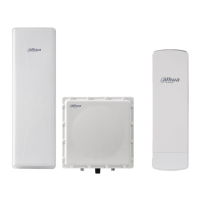30
it is enabled by default.
RTS Threshold: when packet length is over or equivalent to the set value, RTS/CTS mechanism will be
started. To send data, the station will send a RTS to AP, and notify AP that it will send data. After
receiving the request, AP notifies all other stations in its coverage through CTS, and requires them
delaying sending. Meanwhile, AP notifies requesting station to send data.
Fragmentation Threshold: when packet length is over the set value, the packet will be divided into
multiple data fragments, which shall be even number.
Multicast Data: if this function is enabled, DH-PFM88X allows multicast packets to pass DH-PFM88X.
Enable Autonegotiation: when enabled, according to connecting speed and duplex mode of device on
the other end, LAN port automatically adjusts its speed to the highest public level, so both ends of the
line own the highest speed and duplex mode. It is enabled by default, so the user doesn’t need to set.
Enable Full Duplex: it determines whether LAN port of DH-PFM88X allows the data to transmit in two
directions simultaneously.
LAN Speed: LAN port of DH-PFM88X owns two speeds: 10Mbps and 100Mbps.
Signal LED Configure: LED1, LED2 and LED3 settings refer to signal strength value of the device to
turn on 3 LED lights. LED3 signal strength value is the largest (LED3>LED2>LED1); default settings are
LED1:-86dB, LED2:-71dB and LED3:-56dB. LED1 turns on when signal strength is higher than LED1
and lower than LED2. LED1 and LED2 turn on when signal strength is higher than LED2 and lower than
LED3. LED1, LED2 and LED3 turn on when signal strength is higher than LED3.

